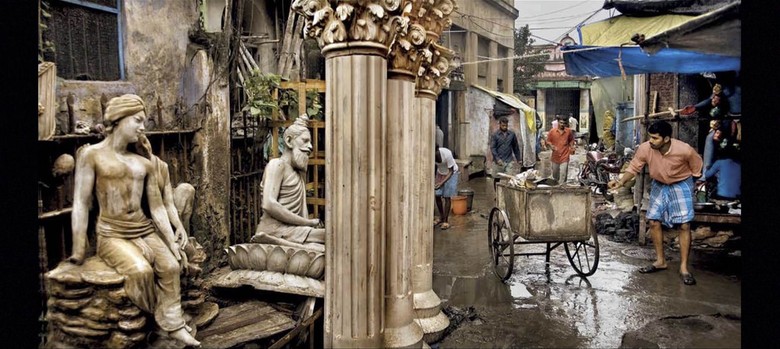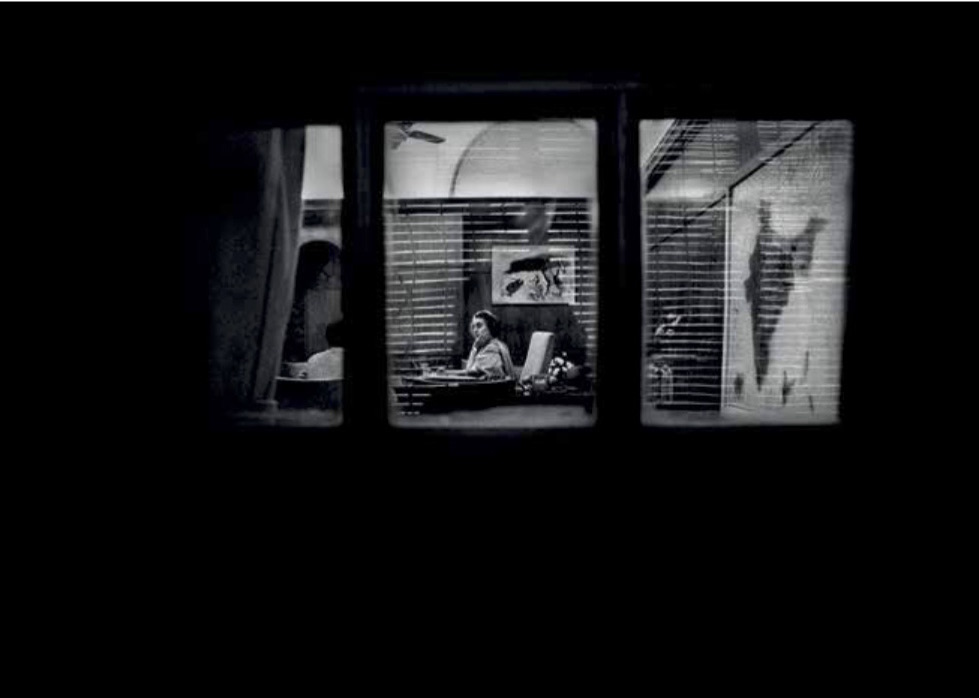
In that time, I quickly go through his new book again, titled Picturing Time: 50 Years of Exceptional Images and The Stories Behind Them and the cover photograph makes a little more sense. It is a photograph of old Delhi’s beautiful landscape – Jama Masjid at the far end and rooftops galore as a woman is seen offering her evening prayers inside her house while dark clouds gather above in the evening sky.
Rai’s relationship with nature is not of the usual kind. He believes strongly in an almost divine revelation that unfolds in front of him like a vision, leading him to see what he does, through the camera. He rarely travels without it.
We set a time to meet in his office in Mehrauli, New Delhi, tucked away in a lane that overlooks Adam Khan’s tomb, popularly known as the Bhool Bhulaiyya. Just by the reception desk are three huge signed prints by the legendary photographers Henri Cartier-Bresson, Martine Franck and Sebastiao Salgado next to each other.
Rai’s room is inside, surrounded by hundreds of books neatly catalogued for reference. His new book is a small yet comprehensive collection of fifty years of his work divided by the decades, starting from the 1960s to now.
Excerpts from the conversation:
In your new book, the introductory note is all about the importance of the “darshan” or the realisation. Did you ever feel the need to sometimes not photograph but only be present in the moment?
You see, a lot of places don’t allow my “instrument of darshan,” which is the camera. I choose to be never present at such places. For me, history and the turn of events are all part of a larger realisation. It is impossible for me to understand all this without a camera – it is a part of myself. I can never be true to my experiences without it.
As a photographer, do you feel more like an active chronicler of history or is it more like being a witness?
I was reading Raza (the painter) and he speaks about the colour red and how it overpowers him until he can’t paint it anymore. Now that is intense. I have always thought of myself as someone who’s made himself available to the events of nature and history. It is important to understand the rhythms of every space that one inhabits because that is what leads to a vision of things. Life and nature have always performed for me and it is this performance that becomes evidence, or history. So at once, you are both the document and the documentarian.
There’s a striking, panoramic visual of villagers in a dust storm on the title page that’s very telling of their plight without the image being literal. What’s the story behind that image and its inclusion in this book?
In 1969, Rajasthan had suffered a massive drought and the Centre allocated some funds that weren’t being used optimally. Prime Minister Indira Gandhi decided to look into the matter. However, on the news of (President) Zakir Husain’s death, she was whisked away in a helicopter shortly after her arrival, leaving the villagers behind with nothing but “metaphoric” dust. I feel that not much has changed even now. There is a big gap between the people and the politics they expect from the leaders that govern the country. The photograph is important because it holds as much ground now as it did back then.

You photographed Indira Gandhi in her political and personal spaces with much ease and access – in particular an image where you made her stand on a ledge that overlooks the Himalayas. Do you think that would be possible to do now with a leader of that stature given that leaders now hand out images that they themselves approve and want circulated?
That was a time when leaders understood artists and the aesthetics that they wanted to employ in order to make a photographic portrait. The leaders came from that space of understanding and reason. I wouldn’t say that it would be easy now, or even possible actually.
Even the media has grown since – in particular, the electronic media, which is largely driven by money and not ethics of content. And as for the crop of leaders now, they don’t want to engage with artists in a way that is too personal or one that lets the photographer into their lives. There are press agencies that handle their official communication and photography and those are the kind of static visuals that we largely see in the newspapers.

When you are working with fifty years’ worth of archives, how do you prioritise an edit when it comes to publishing in the present?
Thanks to digital technology, I’ve managed to catalogue my work very well. I’ve published three or four books a year in the past couple of years and there’s many more to come. For me, the value of an archival image is not just its age but also its aesthetic and importance when viewed today. If I don’t like something I shot thirty years ago, I will edit that out, or try to revisit the shoot and then include it in whatever work I need to. But if it’s just an image without context or aesthetic, there’s no point.
For example, what India remembers visually of Gandhi’s time and his funeral are photographs by the great Henri-Cartier Bresson and Margaret Bourke-White. Of course there were Indian press photographers such as Homai Vyarawalla and Sunil Janah but what Bresson and Bourke-White brought to the table was a vision of history and not some snapshot of news.
You are perhaps the only photographer in India who has spoken publicly about the whole issue of intolerance and the lack of freedom of creative expression – very recently at the Delhi Photo Festival. What are your thoughts on what is happening in the country today?
I’ve been reading about what happened in Dadri and the protest by the writers and artists. For me, it’s very simple – it doesn’t matter who was eating what in whose house. What matters is the violence and the inaction (regarding that act of violence) that followed soon after. It is no wonder that this has infuriated the creative minds in the country because it hurts their gut.
The likes of Anand Patwardhan, Ashok Vajpeyi and Nayantara Sehgal have been crusaders of an equal society since a very long time, and not just during this government’s tenure. It is the duty of the government to stand up at the right time because silence can also be interpreted in many ways. Any government in power must strengthen its country’s social fabric and instill hope in the minds of its citizens.
And finally, I couldn’t help but notice that in your new book, the closing photograph is a very shy, casual self-portrait, dated 2015. Have you finally succumbed to the selfie?
(Laughs). You could say that but I must tell you that I did not use my phone to make that image. I used my Nikon camera. Jatin Das (the artist) and I were returning from Nagpur and this was made somewhere on the way. I don’t like the distortion that phone cameras lend to a person’s features while taking “selfies.” Nobody seems to mind that because it’s a lot of fun but I like a photograph to look good.

Paroma Mukherjee is an independent photographer and the photo editor of Blouin ArtInfo Monthly Art Editions.



